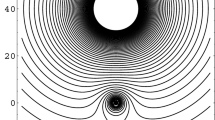Abstract
An exact expression is obtained for harmonic fields in Maxwell electrodynamics with dilatons in terms of elliptic Jacobi functions and elliptic Legendre integrals. The case of centrally symmetric fields is considered individually and effective charges of all three types, that is, electric, magnetic, and dilaton charges, are calculated. An expression is given for the generalized Lorentz force that acts on a test electrically charged particle in these fields.
Similar content being viewed by others
REFERENCES
J. M. Overduin and P. S. Wesson, Phys. Rep. 283, 303 (1997).
D. S. Berman and D. C. Thompson, Phys. Rep. 566, 1 (2014).
D. Youm, Phys. Rep. 316, 1 (1999).
O. V. Kechkin and P. A. Mosharev, Int. J. Mod. Phys. A 31, 1650127 (2016).
O. V. Kechkin and P. A. Mosharev, Mod. Phys. Lett. A 31, 1650169 (2016).
O. V. Kechkin and P. A. Mosharev, in Proceedings of the 16th Interschool Scientific School of Young Specialists on Concentrated Energy Fluxes in Cosmic Engineering, Electronics, Ecology, and Medicine, 2015.
O. V. Kechkin, I. P. Denisova, and P. A. Mosharev, Uch. Zap. Fiz. Fak. Mosk. Univ., No. 3, 1930406 (2019). http://uzmu.phys.msu.ru/abstract/2019/3/1930406
O. V. Kechkin and P. A. Mosharev, Uch. Zap. Fiz. Fak. Mosk. Univ., No. 6, 1960102 (2019). http://uzmu.phys.msu.ru/abstract/2019/6/1960102.
G. M. Fikhtengolts, Course of Differential and Integral Calculus (St. Petersburg, 2016), Vol. 2 [in Russian].
E. T. Whittaker and D. N. Watson, A Course of Modern Analysis (Cambridge Univ. Press, Cambridge, 1927).
I. P. Denisova and O. V. Kechkin, Phys. Part. Nucl. Lett. 15, 464 (2018).
Author information
Authors and Affiliations
Corresponding authors
Additional information
Translated by N. Berestova
APPENDIX
APPENDIX
THE GENERALIZED LORENTZ FORCE
It was shown in [11] that the motion of a test point electrically charged particle in DME fields can be described based on the principle of least action. It was also shown in this work that the classical expression for the Lorentz force must be replaced in the presence of a dilaton by the formula
where \(\mathbf{u}=\gamma\mathbf{v}\), \(\mathbf{v}=d\mathbf{r}/{dt}\), \(\gamma=1/\sqrt{1-\left(\mathbf{v}\right)^{2}}\), \(\mathbf{E}=-\nabla v\), the point denotes the derivative with respect to time, and the functions \(\mathcal{P}\) and \(\mathcal{L}\) are defined as
where \(b\) and \(\varkappa\) are arbitrary constants; their nature was discussed in more detail in [11].
Substituting the expressions obtained in Section 1 for the fields \(v(\lambda)\) and \(\phi(\lambda)\) into this formula, we infer the following exact expression for the generalized Lorentz force that acts on a particle in these fields:
The notations of all quantities involved in this formula have been introduced in Section 1.
The relevant expression for the force that acts on a test particle in the fields found in Section 2 can be written as follows:
Last, the force that acts on a test particle moving in the fields obtained in Section 3 is given by the expression
The last formula uses, by analogy with the previous sections, the notation \(\tau=\mp\frac{\alpha h^{2}}{4}\lambda+\Lambda_{0}\).
About this article
Cite this article
Kechkin, O.V., Mosharev, P.A. A General Harmonic Solution in Dilaton Electrodynamics: An Exact Expression for the Fields and the Generalized Lorentz Force. Moscow Univ. Phys. 75, 427–433 (2020). https://doi.org/10.3103/S002713492005015X
Received:
Revised:
Accepted:
Published:
Issue Date:
DOI: https://doi.org/10.3103/S002713492005015X




